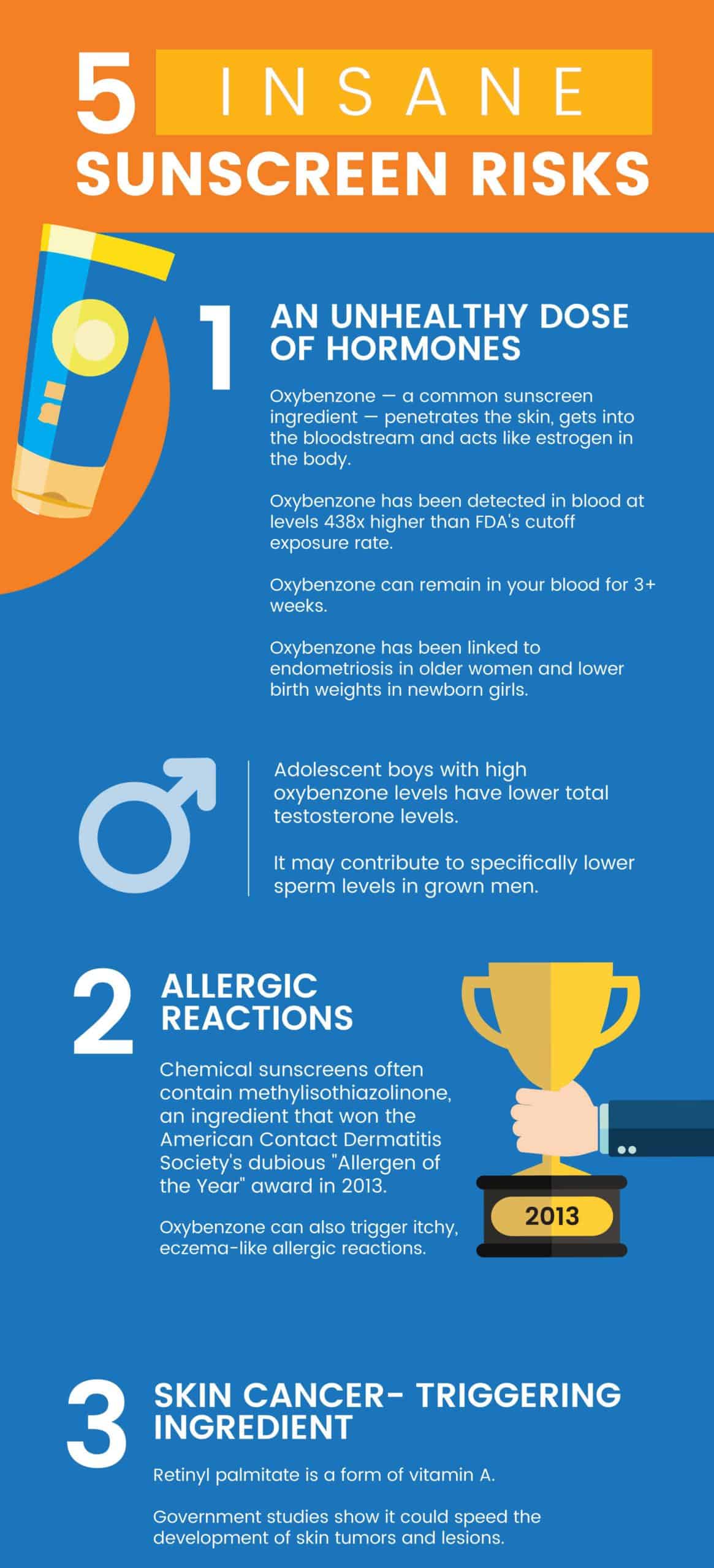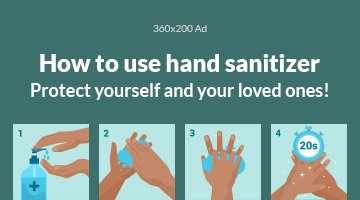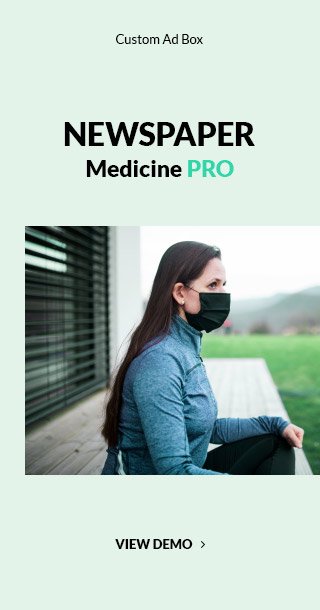It’s no secret that the sun (in moderate doses) provides all sorts of health benefits, including helping our bodies manufacture vital vitamin D. When the sun is strong and the warmer weather rolls in, though, many people are looking for the best sunscreens to cut their risk of sun overexposure, sunburns and possibly skin cancer.
Environmental Working Group’s 18th annual Guide to Sunscreens is a mix of good and bad news when it comes to the state of sunscreens sold in America and beyond. For instance, oxybenzone and octinoxate — suspected hormone-disrupting chemicals that are readily absorbed into the body — were in nearly 300 products EWG examined, as were other troubling ingredients.
The National Toxicology Program released findings linking oxybenzone exposure to a higher risk of thyroid tumors in female rats. Even the European Commission, which reviews ingredient safety in Europe, published a final opinion finding oxybenzone unsafe for use at current levels.
“We slather these ingredients on our skin, but many of these chemicals haven’t been adequately tested,” said Carla Burns, EWG senior director for cosmetic science. “Despite the known toxicity concerns, oxybenzone is still widely used as a non-mineral active ingredient in sunscreens. The long-term use of these chemicals, and especially chemicals not adequately tested for safety, could be problematic.”
To help navigate the sunscreen landscape, the group introduced the EWG VERIFIED® Sunscreen, sunscreens that both meet EWG’s strict standards for sun protection and avoid harmful ingredients. In this 18th annual guide, the group found that only one in four of the more than 1,700 sunscreens reviewed met those standards.
Ad
As EWG explains about EWG VERIFIED®:
EWG Verified recognizes products that meet EWG’s strictest standards for your health, and for sunscreens this includes our high bar for a product’s efficacy.
Drawing upon nearly two decades of experience evaluating sunscreen products, EWG Verified sunscreens meet our strict standards for health and efficacy. These sunscreens cannot contain ingredients banned in the European Union or Canada, and ingredients are required to meet international government restrictions.
Products that earn our mark must also meet higher UVA protection standards that exceed U.S. and European requirements.
Sunscreen Chemicals Build Up in Your Blood
The effects of sunscreen may linger longer than expected, too. An U.S. Food and Drug Administration-led 2020 study found that “chemical sunscreen ingredients are systemically absorbed after one application, and some ingredients can stay in the blood for at least three weeks.”
about:blank
The sunscreen chemicals tested in this FDA study included avobenzone, oxybenzone, octocrylene, homosalate, octisalate and octinoxate, and all six active ingredients tested readily absorbed into the bloodstream of humans involved the study — and at concentrations that surpass an important FDA safety threshold.
This builds on previous research showing that sunscreen chemicals hit the bloodstream within a day of using them — and at levels high enough to prompt a government investigation on safety.
Some public safety experts say this is just one example of the backward nature of product regulation in the U.S.
Beyond safety issues is another question: Does sunscreen even work? EWG found in 2022 that nearly 75 percent of sunscreens don’t work and/or contain concerning ingredients that are readily absorbed by the body.
In addition, EWG found that many sunscreens don’t offer the type of protection you would expect from their listed SPF levels.
Things may be slowing moving in the right direction with FDA trying to update its standards, but for now, the onus is still on the consumer to find sunscreen that’s safer and actually works.
Are You Using the Best Sunscreens?
A past EWG report cited research of Brian Diffey, Ph.D., emeritus professor of photobiology at the Institute of Cellular Medicine at Newcastle University. He’s shown that, on average, U.S. sunscreens allow about three times more UVA rays to transfer through skin compared to European sunscreens.
In fact, Americans’ sunscreen choices are fewer and often offer worse UVA protection compared to those available in the European Union.
This matters because UVA rays are more abundant than UVB rays, and UVA damage is more subtle than the sunburns induced mainly by UVB rays. UVA rays can damage your skin invisibly by suppressing the immune system and aging the skin over time. Overexposure of these rays are also linked to the development of melanoma, squamous cell carcinoma and basal cell carcinoma, too.
According to EWG, most sunscreens sold in the U.S. would not be sold in Europe, which sets much more stringent UVA standards. Specifically, of 51 U.S. products tested, only 35 percent met the EU standard, while 94 percent met the current U.S. standard.
Ad
Excess UVA radiation is tied to aging, immune system damage and a higher risk of certain cancers.
Sunscreen Is Only One Tool in the Sun Safety Toolbox
Now, it’s important to note that there is no perfect sunscreen. Many contain harmful chemicals, and even mineral-based ones could contain nanoparticles, minute ingredients that can cross the blood-brain barrier and also harm aquatic life.
Beyond that, sunscreen is unique compared to many other personal care products because you coat it thickly onto your skin, often multiple times a day. You don’t get that type of hourslong, skin-absorbing exposure with something like, say, shampoo you quickly wash off.
That’s why it’s very important to look for safer sunscreens if you use them and to recognize that you can’t only rely on sunscreens alone to prevent sun overexposure.
No product is going to be fully protective, and no product will last on your skin for more than two hours max, EWG has noted. The group says thickly applying sunscreen coatings, reapplying every time you’re out of the water and choosing a better product to begin with are all key.
Other sun-smart methods to avoid overexposures are a must. In fact, sunscreen should actually be your last line of defense against the sun after adopting other more effective measures. (More on those later.)
“The sunscreen industry continues to bury its head in the sand,” says Scott Faber, EWG’s senior vice president for government affairs. “The market is flooded with products that provide poor UVA protection and use concerning ingredients. Sunscreen sales have increased dramatically, so sunscreen companies can certainly afford to conduct the studies needed to ensure their customers are safe.”
So what are the best sunscreens out there? Let’s take a look.
The Best Sunscreens of 2024: For Recreation
“Based on the best current science and toxicology data, we continue to recommend sunscreens with the mineral active ingredients zinc oxide and titanium dioxide, because they are the only two ingredients the FDA recognized as safe or effective in their proposed draft rules,” Burns says.
In total, 232 recreational sunscreens met the EWG standards in 2024. Here are some of the most highly rated sunscreens that met EWG’s criteria for safety and effectiveness:
- 4ocean Reef Safe Sunscreen Tin, SPF 40
- ATTITUDE Sunly Kids Mineral Sunscreen Stick, Unscented, SPF 30 (and other ATTITUDE products)
- Babo Botanicals Baby Skin Mineral Sunscreen Lotion, SPF 50 (and other Babo Batonicals products)
- Beautycounter Countersun Mineral Sunscreen Stick, SPF 30
- Beautycounter Countersun Mineral Sunscreen Lotion, SPF 30
- Love Sun Body Sheer Perfection Mineral Body Sunscreen, Fragrance-Free, SPF 50
- Love Sun Body Sheer Perfection Mineral Body Sunscreen, Fragrance-Free, SPF 30
- Solara Suncare Go! Mineral Defense Sport Superfruit Body Sunscreen, SPF 50 (and other Solara Suncare Go! products)
- Stream2Sea Every Day Mineral Sunscreen, Tint, SPF 45 (and other Stream2Sea products)
- Thinkbaby Clear Zinc Sunscreen Lotion, SPF 30
- Thinksport Clear Zinc Sunscreen Lotion, Kids, SPF 30 (and other Thinksport products)
The Best Sunscreens of 2024: Daily Use
In total, 143 daily use SPF met the EWG standards in 2024. EWG rated these products to be among the best:
- Ao Skincare 6000X Elemental Screen, SPF 30
- Beautycounter Countersun Daily Sheer Defense for Face, SPF 25
- Biossance Squalane + Mineral, SPF 45
- Love Sun Body Glow Natural Daily Tinted Mineral Face Sunscreen & Moisturizer Lotion, Cocoa, SPF 30 (and other Love Sun Body products)
- Rejuva Minerals Sheer Daily Wear Face Protection, SPF 16
- Solara Suncare Clean Freak Nutrient Boosted Daily Sunscreen, Naturally Scented, SPF 30 (and other Solara Suncare products)
- Sonage Roux Tinted Day Creme, SPF 30
- True Botanicals Skin Barrier Sun Shield, SPF 30
- True Botanicals Everyday Skin Tints, SPF 30
- Well People Bio Tint Tinted Moisturizer, 4W, SPF 30 (and other Well People products)
If you’re looking for lip balm with SPF protection, EWG suggests these picks.
Top Picks for the Best Baby Sunscreens (and Overall Kid-Friendly Picks)
In total, 48 baby sunscreens met EWG standards in 2024. Here were some of the best:
- ATTITUDE Sunly Kids Mineral Sunscreen Stick, Unscented, SPF 30 (and other Attitude products)
- Babo Botanicals Baby Skin Mineral Sunscreen Lotion, SPF 50
- Babo Botanicals Baby Face Mineral Sunscreen Stick, SPF 50
- Stream2Sea Every Day Mineral Sunscreen, Kids, SPF 45
- Stream2Sea EcoStick Sunscreen Stick For Kids, SPF 35+
- Thinkbaby Clear Zinc Sunscreen Lotion, SPF 30
- Thinksport Clear Zinc Sunscreen Lotion, Kids, SPF 30
Most Toxic Sunscreens to Avoid
Here’s a big takeaway that’ll make things somewhat less complicated. EWG recommends avoiding all spray sunscreens.
Not only are they very difficult to apply effectively and evenly, but there’s some concern the ingredients could potentially cause irreversible lung damage. The truth is, the ingredients just haven’t been tested in the aerosol capacity for long-term impact on human health, like so many other everyday chemicals, unfortunately.
In 2021, spray sunscreens contaminated with benzene, a known carcinogen, prompted a sunscreen recall of 14 popular products. Independent testing found that the problem is widespread.
When it comes to sunscreens, here are some of the other worst overall offenders scoring in the Red Zone (10) for major safety concerns. Overall, these products tested poorly in the EWG analysis and are considered bad choices for sun protection.
Just remember, this list is not exhaustive. To check your favorite sunscreen or to peruse the database, click here.
- Banana Boat Ultra Sport Clear Sunscreen Spray, SPF 100
- Alba Botanica Hawaiian Sunscreen Spray, Fragrance Free, SPF 70
- Neutrogena Beach Defense Water + Sun Protection Sunscreen Spray, SPF 60+
- COOLA Classic Body Sunscreen Spray, Peach Blossom, SPF 70
- Equate Beauty Ultra Light Sunscreen Lotion, SPF 100
- Banana Boat Ultra Sport Clear Sunscreen Spray, SPF 65
- Neutrogena Beach Defense Water + Sun Protection Sunscreen Spray, SPF 70
- Banana Boat Kids Max Protect and Play Broad Spectrum Sunscreen, SPF 100 (2018 formulation)
- Hawaiian Tropic Weightless Hydration Sunscreen Clear Spray, SPF 70
- Banana Boat Kids Clear Sunscreen Spray, SPF 65
- Bare Republic Clearscreen Sunscreen Spray, SPF 100
- Banana Boat Kids MAX Clear Sunscreen Spray, SPF 100
- Banana Boat Ultra Defense Clear Sunscreen Spray, SPF 100
- La Roche-Posay Anthelios Ultra Light Sunscreen Lotion Spray, SPF 60
- Banana Boat Ultra Sport Sunscreen Lotion, SPF 100
- Panama Jack Sunscreen Lotion, SPF 100
- The Seaweed Bath Co. Sport+ Cooling Mist, Peppermint & Aloe, SPF 60
- CVS Health Ultra Sheer Sunscreen Lotion, SPF 100
- Best Choice Sport Broad Spectrum Spf 70 Sunscreen Spray
This is by no means a complete list. Be sure to check your individual product’s safety assessment at EWG.org.


Key Findings in EWG’s Sunscreen Report
- EWG recommends avoiding high-SPF sunscreens, as they’ve been shown that they provide limited benefits compared to lower-SPF sunscreens, and they can give people a false sense of security against the sun.
- Spray sunscreens contain cancer-causing benzene, so you should avoid them.
- Europe continues to do a far better job at sunscreen regulation than the U.S. “EWG estimates that most sunscreens sold in the U.S. would be too weak for the European market because they don’t filter UVA rays well enough. An EWG study of laboratory tests of 51 sunscreen products found that only 35 percent of the products tested met the EU standard, but 94 percent would pass the current U.S. standard.”
- Your skin is your body’s largest immune system organ. Excess sun exposure can impair the immune system, but many sunscreen chemicals are readily absorbed into the bloodstream, where they could cause ill effects, too.
- Stanford University dermatologists concluded that people who relied solely on sunscreens for sun protection got more sunburns than people who reported infrequent sunscreen use but wore hats and clothing to shield themselves from the sun.
- An EWG analyst warns: “Sunscreen is only one form of sun protection and should not be relied on alone. It’s also important to wear sunglasses, hats and t-shirts, stay in the shade, and avoid the midday sun.”
- The rate of new melanoma cases among American adults has tripled since the 1970s.
- Evidence is increasing that UVA exposure causes skin cancer. Despite that, sunscreen rules requiring adequate UVA protection are lacking.
- Oxybenzone is in widespread use in American chemical-based sunscreens. Lab testing shows skin penetration rates of 1 percent to 9 percent. That’s concerning, given the fact that it acts like an estrogen in the body and is linked to abnormal sperm function in animal studies and endometriosis in studies of women. Oxybenzone also acts as a skin allergen in a significant number of people. (So does methylisothiazolinone, a common sunscreen preservative found in the majority of products surveyed.) Thankfully, places like Hawaii and Key West have banned oxybenzone in sunscreen due to its ability to bleach and kill coral reefs.
- In a previous EWG review, about 40 percent of sunscreens contained vitamin A ingredients. This type of ingredient can react with UV rays and increase the risk of skin tumors, according to government animal testing data.
- Scientists don’t know for sure if sunscreen helps prevent melanoma. In fact, as EWG notes in its executive summary of the sunscreen guide, “Sun exposure appears to play a role in melanoma, but it is a complex disease for which many questions have not been answered. One puzzling fact: Melanomas do not usually appear on parts of the body that get daily sun exposure.”
- Be wary of ultra high SPF claims. There are more of them today than several years ago. The U.S. hasn’t approved modern sunscreen ingredients that would do a better job of broad-spectrum protection.
- Avoid spray sunscreens. It’s very difficult to apply in a thickness that will provide adequate protection, plus it increases the risk you’re sending potentially damaging sunscreen chemicals directly into your lungs (and the lungs of everyone sitting around you).
- The FDA is proposing that all sprays and powders undergo additional proposes that all spray products undergo additional safety testing to ensure they can’t be inhaled deep into the lungs and cause irreversible damage.
- Inactive ingredients often make up 50 percent to 70 percent of sunscreen formulations, and EWG urges the FDA to investigate the safety of these ingredients, too.
- FDA pilot testing uncovered spray sunscreen products that would not meet proposed standards.
- EWG recommends that consumers avoid all spray and powder sunscreen products.
- If you’re opting for sunscreen for protection from overexposure to the sun, EWG advises to opt for mineral-based sunscreen products with zinc oxide or titanium dioxide active ingredients and avoid products with ingredients like oxybenzone and retinyl palmitate.
- If you avoid the sun, get your vitamin D levels checked at your health care provider. A growing number of the population is deficient, thanks to sunscreens and spending more time indoors.
The good news is you can get enough vitamin D and protect yourself from burns without always turning to sunscreen.
How to Avoid Too Much Sun
Getting some sun exposure is vital for good health because it helps your body create vitamin D. There are multiple ways to get vitamin D, but your best bet is to get it from standing in the sun or eating vitamin D-rich foods. In fact, sitting in the sun unexposed for about 10 minutes helps your body create roughly 10,000 units of natural vitamin D.
Vitamin D deficiency has been linked to certain cancers, autoimmune diseases, heart disease, depression, osteoporosis and many other ailments, so it’s important to get enough. Like almost anything, though, you can get too much of a good thing and want to make sure you avoid sunburns.
You should consider sunscreen your last resort to prevent sunburns, though. In fact, there’s no clear evidence that using sunscreens actually prevents skin cancer — including in the best sunscreens — and some ingredients may actually fuel skin cancer.
Avoid overexposure during peak sunlight hours, and use sunglasses and sun-protective hats and clothing. These things reduce your risk of burns without sunscreen.
Final Thoughts
- When direct sunlight hits our skin under peak conditions, our bodies manufacture high levels of vitamin D. Not getting enough vitamin D has been linked to all sorts of health problems, including cancer, arthritis, depression and other diseases.
- However, you can get too much of a good thing, which is why it’s important to take steps to prevent overexposure and sunburns.
- There is no perfect sunscreen. Mineral sunscreens generally rate safer, but they often contain nanoparticles that are not tightly regulated or studied for long-term impact on human or aquatic health. Chemical sunscreens often contain hormone-disrupting chemicals or even an ingredient that could trigger skin cancer. Still, EWG’s report helps consumers seeking sunscreen find safer choices while avoiding the most poorly rated brands.
- Sunscreen should be used as a last resort. Sun-protective measures like hats, sunglasses, seeking shade and avoiding peak sunlight for extended periods of time should be used before turning to sunscreen, and when you do choose sunscreen, make sure it’s one of the best sunscreens.





